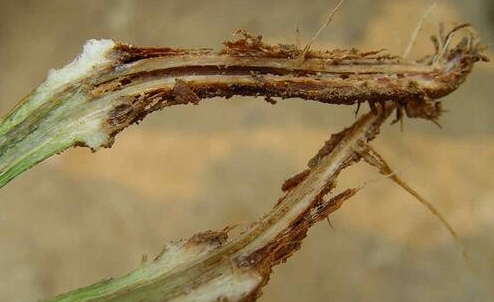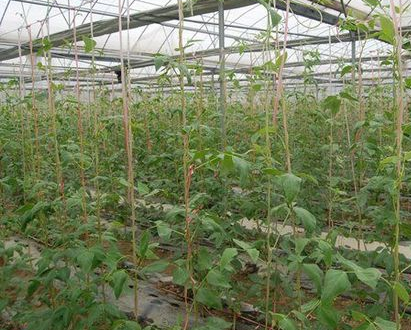In the greenhouse, weaving cowpeas, usually the wintering cucumbers of the upper glutinous rice, will be planted with live seeding in the late spring season or before the cultivating of cucumbers. When the price of cucumber is low or the cucumber is plucked, the cowpea is on the market.
However, cowpeas were originally open-planted crops, and many vegetable farmers lacked anti-seasonal cultivation experience. In particular, there is still a lack of understanding of cowpea disease, and it is difficult to treat the disease in prevention and treatment.
The most common diseases of greenhouse cowpea are: root rot, brown spot, rust and Liriomyza sativae, which is commonly referred to as “three diseases and one insectâ€.

1. Kidney bean root rot: The pathogen survives in the sick body, spread by agricultural tools, rainwater and irrigation water, and the disease is severe under high humidity conditions. Mainly harmful to the roots and stem base, the main feature of the disease is brown or black spots in the diseased part, the diseased plants are easy to pull off, the roots are longitudinally sectioned, the vascular bundle is reddish brown, the roots begin to rot, and the upper leaves of the diseased plants are yellow and chlorotic, such as If it is not treated in time, the roots will all rot and the upper stems will die. Too much watering, continuous cropping.
Control measures: high ridge cultivation should be adopted. First, strong seedlings should be cultivated in advance, and secondly, live broadcast can be adopted. Watering should be carried out in the early stage, and it should not be flooded. When the seedlings grow, when the seedling growth height reaches 10 cm, each tree is filled with 3000 times liquid and 3000 times liquid Shuofeng 481, and carbendazim or methyl thiophanate 800 can be used for root rot. Double liquid plus dead root 1500 times liquid irrigation;
2, cowpea brown spot: the front and back of the leaf produces a nearly round or irregular brown spot, the edge is russet, the outer edge has a yellow halo, the middle part of the lesion becomes grayish white or gray-brown, and the leaf spot is slightly darker. The edges are still russet. When the temperature is high, the lesion on the back of the leaf produces gray-black mildew. The disease is most suitable for the onset temperature of 20-25 ° C, relative humidity of more than 80%, high temperature and high humidity, planting too dense, poor ventilation, partial application of nitrogen fertilizer, the incidence is heavier.
Control measures: rational close planting, increase application of phosphorus and potassium fertilizer, clean the garden in time after cultivation.
Drug control: use 10% difenoconazole water dispersible granules 1500-2000 times liquid plus 4000 times liquid Shuofeng 481; can also be used Bang Jiawei 500 times liquid plus 40% mycotoxin water dispersion granules 6000 times solution, Depending on the condition, spray once every 7-10 days, even spray 2-3 times.

3, cowpea powdery mildew: the onset temperature is between 20-30 ° C, relative humidity 40% -95%, generally in the middle and late stages of flowering and pod formation, if not timely treatment of the disease faster.
Symptoms of the disease: mainly damage the leaves, first the yellow-brown spots appear on the leaves, and then the purple-brown spots are enlarged. The leaves are covered with a thin layer of white powder. The late lesions develop along the veins, the white powder is covered with whole leaves, and the back of the leaves with heavy incidence sometimes Can also show symptoms.
Prevention and treatment methods:
(1) Phosphorus-potassium fertilizer and deep-cultivation soil conditioner are used in the selection of fertilizers to avoid deep ploughing and loosening soil, increase soil permeability, improve the disease resistance of cowpea, and reduce the occurrence of powdery mildew.
(2) before and after the onset of foliar spray, Puxing 1200 times liquid plus 4000 times liquid Shuofeng 481, pay attention to spraying the leaves against the front, spray once every 7-10 days, even spray 2-3 times; also use 30% ether The fungic ester suspension agent 2000-2500 times liquid was sprayed on the foliar surface.
4. Liriomyza sativae. The genus Diptera, the genus Diptera, due to drought in the greenhouse, the temperature inside the shed is high, and it can survive in the greenhouse for a long time, especially for cowpea. The damage of the larvae of the genus Liriomyza sinensis is mainly caused by the leaves, and the larvae are the weight of the larvae. The serpentine curved tunnel is formed by the thinning and widening of the leaves. The initial stage is white, and later becomes rust color. The larvae are often in a short time. He was killed by the drill.
Control measures: You can use Xuan Xing (Avi. Triazophos), 40-60 ml per acre plus 4000 times liquid Shuofeng 481 foliar spray, 50% fly amide wettable powder 2000-3000 times liquid The control effect is better.
China Extract Powder For Use As Dietary Supplement Extract Powder, Extract Powder Manufacturer
Shaanxi Kang New Pharmaceutical co., Ltd. , https://www.bodybuildingoil.com